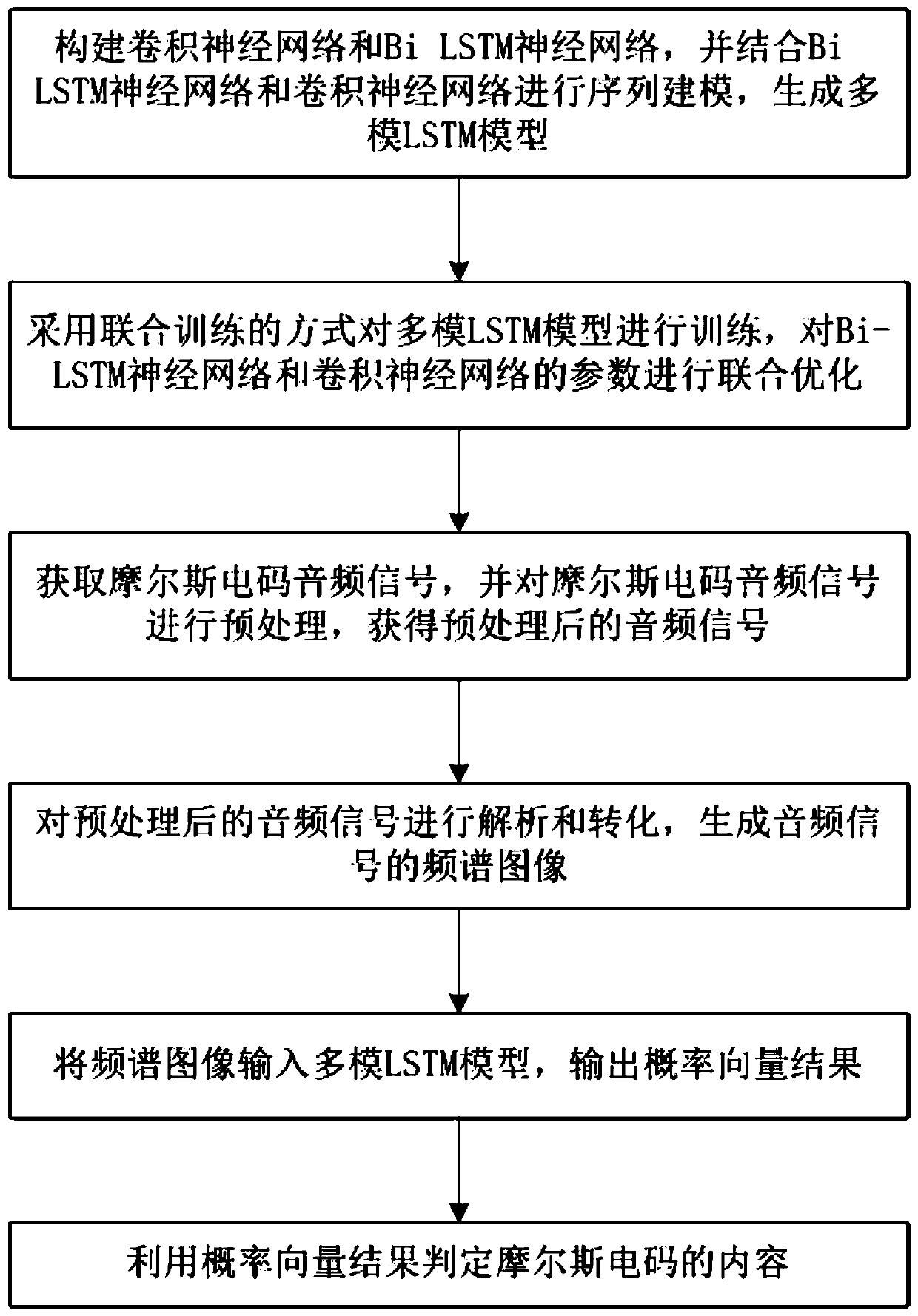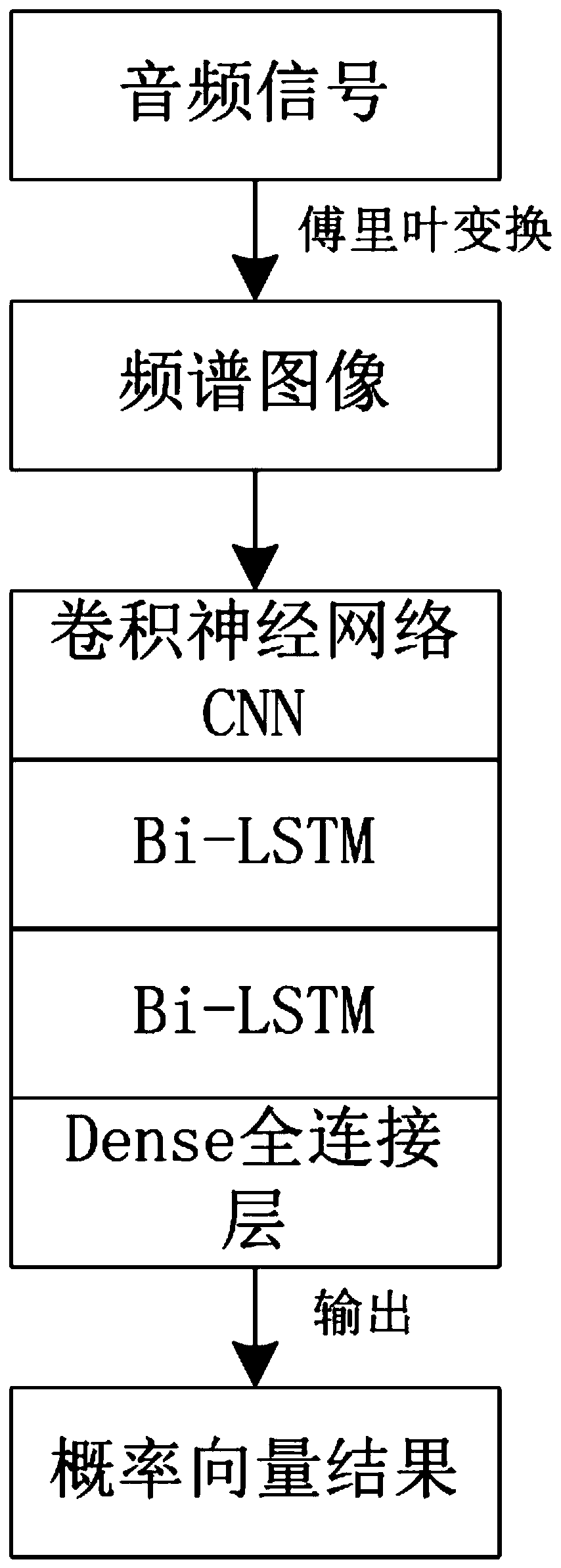Morse code automatic identification method based on Bi-LSTM neural network
A neural network and automatic identification technology, applied in the field of communication signal processing, can solve the problems of short working time, unfavorable copying, and high labor intensity of the operator, and achieve the effect of improving processing efficiency, increasing depth, and accurate processing results.
- Summary
- Abstract
- Description
- Claims
- Application Information
AI Technical Summary
Problems solved by technology
Method used
Image
Examples
Embodiment 1
[0046] The present embodiment provides the automatic recognition method of Morse code based on Bi-LSTM neural network, such as Figure 1 to Figure 2 shown, including the following steps:
[0047] S1. Construct a convolutional neural network and a Bi-LSTM neural network, and combine the Bi-LSTM neural network and the convolutional neural network for sequence modeling to generate a multi-mode LSTM model;
[0048] S2. The multi-mode LSTM model is trained by means of joint training, and the parameters of the Bi-LSTM neural network and the convolutional neural network are jointly optimized;
[0049] S3. Acquire the Morse code audio signal, and preprocess the Morse code audio signal to obtain the preprocessed audio signal;
[0050] S4. Analyzing and converting the preprocessed audio signal to generate a spectrum image of the audio signal;
[0051] S5. Input the spectrum image into the multi-mode LSTM model, and output the probability vector result;
[0052] S6. Using the result o...
Embodiment 2
[0063] As an optimization to the above-mentioned embodiment, in step S1, the constructed Bi-LSTM neural network is a bidirectional multilayer Bi-LSTM neural network, and the output data of each layer in the bidirectional multilayer Bi-LSTM neural network is used as the next layer input data.
[0064] The Bi-LSTM neural network can be expressed as:
[0065] S t =f(UX t +WS t-1 )
[0066] S t ’=f(U’X t +W'S t+1 ')
[0067] OT=g(VS t +V'S t ')
[0068] Among them, S t Indicates the hidden layer state value of t spectral point, S t 'Represents the reverse hidden layer state value of t spectral point, OT represents the value of the output layer of t spectral point, S t-1 Indicates the hidden layer state value of the t-1 spectral point, S t+1 'Represents the reverse hidden layer state value of t+1 spectral point, g, f represent different activation functions, X t Represents the input vector, U represents the weight matrix from the input layer to the hidden layer, U' r...
Embodiment 3
[0071] As an optimization of the above-mentioned embodiment, in step S3, the process of preprocessing the Morse code audio signal includes volume normalization processing, signal amplification processing, high-pass filtering processing and signal noise reduction processing, and the volume normalization processing makes the volume of the audio clip Regional average, high-pass filter processing to filter out low-frequency environmental noise with a frequency lower than 300Hz.
[0072]In step S4, when converting the preprocessed audio signal, Fourier transform is used to convert the preprocessed audio signal into a spectrum image, and the sampling frequency is 8000 Hz. Before performing the Fourier transform process, first enhance the strength of key frequency signals in the audio signal (linear enhancement, coefficient 1.2), and the key frequency range is 1000Hz±100Hz.
PUM
 Login to View More
Login to View More Abstract
Description
Claims
Application Information
 Login to View More
Login to View More - R&D
- Intellectual Property
- Life Sciences
- Materials
- Tech Scout
- Unparalleled Data Quality
- Higher Quality Content
- 60% Fewer Hallucinations
Browse by: Latest US Patents, China's latest patents, Technical Efficacy Thesaurus, Application Domain, Technology Topic, Popular Technical Reports.
© 2025 PatSnap. All rights reserved.Legal|Privacy policy|Modern Slavery Act Transparency Statement|Sitemap|About US| Contact US: help@patsnap.com


